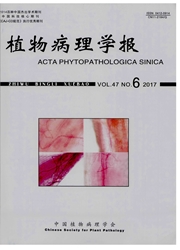

 中文摘要:
中文摘要:
2015年春季在昆明市区绿化带种植的中华常春藤上发现一种由细菌侵染而引起的病害,称为中华常春藤细菌性叶斑病。通过发病症状、菌落形态观察、致病性测定、Biolog分析,16S rDNA序列和核糖体DNA内转录间隔区(internal transcribed spacer,ITS)序列分析比较,对昆明地区的常春藤叶斑病病原菌及其系统进化关系进行研究。分离病原菌接种中华常春藤叶片完成科赫法则验证,发病初期在叶片表面形成带有黄色叶晕的不规则褐色斑点,后期叶片边缘形成倒V字型坏死并起皱。将菌株CCT1和CCT6测序结果与现有的黄单胞菌菌株的16S rDNA序列和核糖体DNA的ITS序列构建进化树,结果均显示病原菌与野油菜黄单胞菌的序列相似度最大,属于同一支。研究确定该病原菌为野油菜黄单胞菌(Xanthomonas campestris)。这是中国首次报道由X.campestris引起的中华常春藤叶斑病。
 英文摘要:
英文摘要:
In the spring of 2015, symptoms of a suspected bacterial leaf spot were observed on leaves of Hedera nepalensis vat. sinesis plants growing in a green belt in Kunming, Yurman Province. The symptoms of the dis- ease were described and the morphology analysis, the pathogenicity test, Biolog test and analysis of 16S rDNA gene sequence and 16S-23S rDNA internal transcribed spacer (ITS) of the typical isolates were performed to elucidate the causative bacterial pathogen. The pathogenicity test result indicated that the bacterial pathogen isolated from the diseased plants could fulfill Koch's postulate. The initial symptoms of the disease were hregular brown leaf spots, surrounded by yellow haloes and located on the edges of the leaves. As the disease progressed, these leaf spots expanded and joined together to form bigger inverted V-shaped necrotic specks. The strains CCT1 and CCT6, isolated from the diseased plants were most closely related to Xanthomonas campestris in the phylo-genetic tree constructed based on 16S rDNA and ITS sequences of Xanthomonas strains. All the results revealed that the causal agent of bacterial leaf spot on H. nepalensis var. sinensis belonged to X. campestris. This is the first report of X. campestris as a pathogen of H. nepalensis var. sinensis in China.
 同期刊论文项目
同期刊论文项目
 同项目期刊论文
同项目期刊论文
 期刊信息
期刊信息
